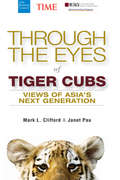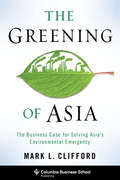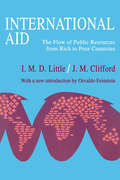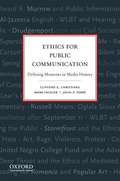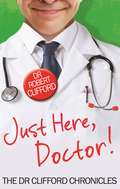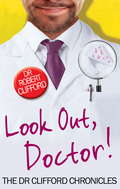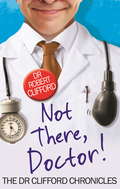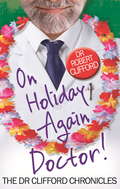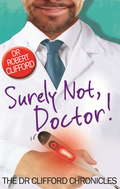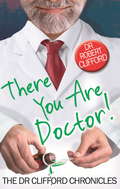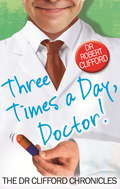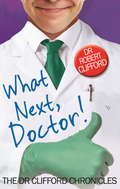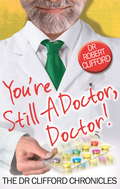- Table View
- List View
A Lone Ranger: Real World Strategies for Applying Growth Opportunity Scans, Assessing Product Extensions, and Realizing the Potential of Radical Innovations
by Patricia Gorman Clifford Jay Barney"What I Didn't Learn in Business School" is a fictional account that follows new consultant Justin Campbell as he joins an elite team hired by a chemical firm to assess the potential of a newly developed technology. This chapter finds Justin struggling to get a handle on several different applications for this technology in order to determine the growth opportunity and lay the groundwork for choosing the highest-potential innovations. Learn from his mistakes as he looks for ways to organize information effectively and evaluates strategic opportunities. This chapter was originally published as Chapter 8 of "What I Didn't Learn in Business School: How Strategy Works in the Real World."
A Moving Target: Real World Strategies for Applying 5 Forces, Selecting and Using Appropriate Tools, and Reacting to Feedback
by Patricia Gorman Clifford Jay Barney"What I Didn't Learn in Business School" follows new consultant Justin Campbell as he joins an elite team hired by a chemical firm to assess the potential of a newly developed technology. Read along as Justin meets with a vice president, the second-in-command at the chemical firm. Throughout the interview, Justin learns that a particular mode of analysis is not applicable to every situation. Like any newcomer, he tries to match a case study to a real-world situation-but business is not a science. In the real world, it's often difficult to distinguish the wrong from the right approach. Different strategies, as Justin learns, have advantages and disadvantages in different scenarios. In this chapter, authors Jay Barney and Trish Gorman Clifford demonstrate how to develop real-world strategies for applying the Five Forces framework, and for using feedback to your advantage. This chapter was originally published as Chapter 3 of "What I Didn't Learn in Business School: How Strategy Works in the Real World."
A New Shirt: Real World Strategies for Identifying Purchasing Criteria, Understanding Segmentation, and Using NPV Analyses Strategically
by Patricia Gorman Clifford Jay Barney"What I Didn't Learn in Business School" is a fictional account that follows new consultant Justin Campbell as he joins an elite team hired by a chemical firm to assess the potential of a newly developed technology. Justin meets with the firm's chief financial officer, who challenges Justin's assumptions about financial analysis. Thankfully, with feedback from more experienced colleagues Justin begins to understand the role of a CFO. In this chapter, authors Jay Barney and Trish Gorman Clifford show how financial analysis often fails to present clear logic, how individual biases and corporate politics can affect a company's financial analysis, and how to develop better real-world strategies for dealing with these issues. This chapter was originally published as Chapter 2 of "What I Didn't Learn in Business School: How Strategy Works in the Real World."
A Seamless Argument: Real World Strategies for Syndicating Recommendations, Understanding Managers' Motives, and Preparing an Organization for Change
by Patricia Gorman Clifford Jay Barney"What I Didn't Learn in Business School" is a fictional account that follows new consultant Justin Campbell as he joins an elite consulting team hired by a chemical firm to assess the potential of a newly developed technology. Collecting data, analyzing information, and developing a strategy are core components of Justin's job. The most important part, however, is selling his ideas. Unfortunately, and especially for recent business school graduates, that is a very difficult skill to learn. In this chapter, follow Justin and his team as they prepare to sell their carefully tested strategic recommendations to their client. As they craft their presentation, they must anticipate the motivations and potential objections of the firm's managers, develop strategies for gaining buy-in, and lay the groundwork for change. This chapter was originally published as Chapter 13 of "What I Didn't Learn in Business School: How Strategy Works in the Real World."
A Simple Problem: Real World Strategies for Managing First Impressions, Scoping an Engagement, and Performing Situation Analysis with Limited Information
by Patricia Gorman Clifford Jay Barney"What I Didn't Learn in Business School" follows new consultant Justin Campbell as he joins an elite team hired by a chemical firm to assess the potential of a newly developed technology. In this fictional account, authors Jay Barney and Trish Gorman Clifford take you into the mind of a new consultant as he encounters the challenges of applying business school lessons in the real-world-the way a traditional book on business strategy never could. This chapter introduces Justin on his first day as he meets his new colleagues, prepares for his first client meetings, and confronts the complexities of organizational politics as he begins to gather information on the client's business. This chapter was originally published as Chapter 1 of "What I Didn't Learn in Business School: How Strategy Works in the Real World."
A Sweeping Vision: Real World Strategies for Observing Team Dynamics, Evaluating Outrageous Targets, and Developing Effective Interview Protocols
by Patricia Gorman Clifford Jay Barney"What I Didn't Learn in Business School" is a fictional account that follows new consultant Justin Campbell as he joins an elite team hired by a chemical firm to assess the potential of a newly developed technology. Consulting, as many recent MBA graduates learn, is more than analyzing data and cracking cases. In this chapter, Justin learns some important lessons about working with different personalities, developing plans for client interviews that yield revealing results, and weighing risk and reward to manage audacious goals. Authors Jay Barney and Trish Gorman Clifford demonstrate through Justin's struggles that in the real world, strategy development does not happen by analysis alone--it requires listening, sharing, and asking the tough, insightful questions that will help you grasp organizational complexities and determine the best course of action given the circumstances. This chapter was originally published as Chapter 7 of "What I Didn't Learn in Business School: How Strategy Works in the Real World."
A Tailored Presentation: Real World Strategies for Anticipating Resistance to Recommendations, Making High Impact Presentations, and Aligning Organizational Structure with Strategic Objectives
by Patricia Gorman Clifford Jay BarneyThis chapter was originally published as Chapter 14 of "What I Didn't Learn in Business School: How Strategy Works in the Real World."
A Team Effort: Real World Strategies for Justifying Vertical Integration, Considering Joint Ventures, and Understanding Organizational Dynamics
by Patricia Gorman Clifford Jay Barney"What I Didn't Learn in Business School" is a fictional account that follows new consultant Justin Campbell as he joins an elite team hired by a chemical firm to assess the potential of a newly developed technology. At the opening of this chapter, Justin realizes that the work he has been doing alone on the new project overlaps significantly with the work that his colleagues have done. While attempting to crack the strategy case on his own, he has failed to leverage the value of his team. Through Justin's struggles, authors Jay Barney and Trish Gorman Clifford underscore the virtues of teamwork as Justin and his colleagues explore the potential of vertical integration and joint ventures as strategic options for their client. This chapter was originally published as Chapter 9 of "What I Didn't Learn in Business School: How Strategy Works in the Real World."
A Thoughtful Workout: Real World Strategies for Receiving Tough Feedback, Seeking Competitive Advantage, and Populating Frameworks with Incomplete Information
by Patricia Gorman Clifford Jay Barney"What I Didn't Learn in Business School" is a fictional account that follows new consultant Justin Campbell as he joins an elite team hired by a chemical firm to assess the potential of a newly developed technology. This chapter joins Justin, as he processes some tough criticism from his boss about his inability to step back and see the big picture objectively, rather than getting caught up in the persuasive, but potentially biased arguments of the individuals working on the ground in the client organization. Authors Jay Barney and Trish Gorman Clifford allow you to experience the disheartening mistakes of a new consultant and in the process, learn how to avoid certain pitfalls and develop informed and clear-sighted perspectives as you analyze your strategic options. This chapter was originally published as Chapter 6 of "What I Didn't Learn in Business School: How Strategy Works in the Real World."
A Valuable Chain: Real World Strategies for Analyzing the Value Chain, Applying the VRIO Framework (Resource Based View), and Recognizing Core Competencies
by Patricia Gorman Clifford Jay Barney"What I Didn't Learn in Business School" invites readers to follow new consultant Justin Campbell as he joins an elite team hired by a chemical firm to assess the potential of a newly developed technology. To this point Justin has struggled with translating his MBA knowledge into real-world application, but he's finally starting to see how theories and frameworks, like VRIO (Valuable, Rare, Imitable, and Organization), can have real-world impact. In this chapter, authors Jay B. Barney and Trish Gorman Clifford take you into the world of this fictional consultant as he evaluates his client's value chain and identifies its sources of core competence using the VRIO framework. This chapter was originally published as Chapter 5 of "What I Didn't Learn in Business School: How Strategy Works in the Real World."
A Working Lunch: Real World Strategies for Assessing Potential Synergies, Evaluating Make v. Buy Decisions, and Communicating Effectively with Team Members
by Patricia Gorman Clifford Jay Barney"What I Didn't Learn in Business School" invites readers to follow new consultant Justin Campbell as he joins an elite team hired by a chemical firm to assess the potential of a newly developed technology. Join Justin in this chapter as he meets with the vice president in charge of running the firm's struggling package factory and listen in as Justin's team discusses strategies for testing synergies and weighs the intricacies of outsourcing the manufacturing of the new technology vs. the client bringing the work in-house. Authors Jay Barney and Trish Gorman Clifford bring these strategy lessons to life, inviting you to learn first-hand from Justin's mistakes as he works with his team to evaluate different approaches. This chapter was originally published as Chapter 4 of "What I Didn't Learn in Business School: How Strategy Works in the Real World."
Through the Eyes of Tiger Cubs
by Mark L. Clifford Janet PauWhat will Asia look like ten years from now? Find out by taking a look through the eyes of the Asia's next generation of leaders Following economic booms in Hong Kong, Singapore, South Korea, and Taiwan--the four Asian Tigers--attention has shifted to success stories in other Asian economies. However, a number of challenges have also emerged that could threaten the region's development over the next decade. Through the Eyes of Tiger Cubs offers a unique glimpse into the younger generation's view of Asia's future. It draws on the perspective of more than 80 visionary young Asians, who have identified the key issues and who see innovative solutions for areas as diverse as education and labor markets, demographics and healthcare, energy and the environment, and governance and geopolitics. The book's insights are based on a collection of think-pieces from a broad range of young Asians--the result of a competition organized by the Asia Business Council, Time magazine, the Lee Kuan Yew School of Public Policy at the National University of Singapore, as well as additional research by the Council. The book is unique in that it: Provides a viewpoint in contrast to the usual perspective of businesses, governments, economists, and journalists Brings together the responses of almost a hundred young Asian thinkers to the questions "What is the biggest challenge facing Asia over the next ten years?" "Why?" and "What should be done about it?" Offers policy makers, business leaders, and others who are concerned about the future of Asia a unique glimpse into the younger generation's vision The next generation has a high stake in ensuring Asia's long-term growth. Gain a unique perspective on how the leaders of tomorrow see the future.
The Greening of Asia
by Mark L. CliffordOne of Asia's best-respected writers on business and economy, Hong Kong-based author Mark L. Clifford provides a behind-the-scenes look at what companies in China, India, Japan, Korea, the Philippines, South Korea, Singapore, and Thailand are doing to build businesses that will lessen the environmental impact of Asia's extraordinary economic growth. Dirty air, foul water, and hellishly overcrowded cities are threatening to choke the region's impressive prosperity. Recognizing a business opportunity in solving social problems, Asian businesses have developed innovative responses to the region's environmental crises.From solar and wind power technologies to green buildings, electric cars, water services, and sustainable tropical forestry, Asian corporations are upending old business models in their home countries and throughout the world. Companies have the money, the technology, and the people to act -- yet, as Clifford emphasizes, support from the government (in the form of more effective, market-friendly policies) and the engagement of civil society are crucial for a region-wide shift to greener business practices. Clifford paints detailed profiles of what some of these companies are doing and includes a unique appendix that encapsulates the environmental business practices of more than fifty companies mentioned in the book.
The Greening of Asia: The Business Case for Solving Asia's Environmental Emergency (Columbia Business School Publishing Ser.)
by Mark CliffordOne of Asia's best-respected writers on business and economy, Hong Kong-based author Mark L. Clifford provides a behind-the-scenes look at what companies in China, India, Japan, Korea, the Philippines, Indonesia, Hong Kong, Singapore, and Thailand are doing to build businesses that will lessen the environmental impact of Asia's extraordinary economic growth. Dirty air, foul water, and hellishly overcrowded cities are threatening to choke the region's impressive prosperity. Recognizing a business opportunity in solving social problems, Asian businesses have developed innovative responses to the region's environmental crises. From solar and wind power technologies to green buildings, electric cars, water services, and sustainable tropical forestry, Asian corporations are upending old business models in their home countries and throughout the world. Companies have the money, the technology, and the people to act—yet, as Clifford emphasizes, support from the government (in the form of more effective, market-friendly policies) and the engagement of civil society are crucial for a region-wide shift to greener business practices. Clifford paints detailed profiles of what some of these companies are doing and includes a unique appendix that encapsulates the environmental business practices of more than fifty companies mentioned in the book.
International Aid: The Flow of Public Resources from Rich to Poor Countries
by J. M. CliffordThis is a comprehensive analysis of the economics of international aid that provides a systematic framework for understanding, planning, and executing aid programs. Though much has been written on different aspects of international aid, this book was the first to synthesize information on all facets of aid and to investigate the consequences, for both donor and recipient nations, of the transfer of public resources in aid programs. The authors first present the history of aid, discuss the principles that govern aid as practiced by the United States, the United Kingdom, Russia, China, the United Nations, and other donors, and then provide a broad theoretical structure in which to discuss particular questions taken up in subsequent chapters. The book systematically covers all aspects of the aid relationship, and in addition to broad coverage of aid programs, analyzes details of the aid relationship to discern the function of the different variables of aid. In one coherent volume, International Aid outlines sound theoretical bases for discussion of aid programs, provides valuable insights into contemporary practices, and offers far-reaching suggestions on the future of aid programs. On first publication in the mid-1960s, in the midst of the Cold War, this book had considerable influence and its interest outlasts its parochial times as one of the first to discuss the effects of aid on both donor and recipient countries.
Ethics for Public Communication: Defining Moments in Media History
by Clifford G. Christians; Mark Fackler; John P. FerreFocusing on one historic episode per chapter, Ethics for Public Communication is divided into three parts, each dedicated to one of the three major functions of the media within democratic societies: news, persuasion, and entertainment. Authors Clifford Christians, Mark Fackler, and John Ferré, three trusted scholars in the field, discuss media ethics from a communicative perspective, setting the book apart from other texts in the market that simply combine journalism with libertarian theory. Classic media ethics cases, like the publication of Rachel Carson's 1962 book Silent Spring, are covered in tandem with such contemporary cases as the creation of Al-Jazeera English and the controversy surrounding Ice-T's protest song, "Cop Killer."
Just Here, Doctor (The Dr Clifford Chronicles)
by Dr Robert CliffordJust Here, Doctor is the true story of a young country doctor and his patients - a richly entertaining and humorous chronicle of the life of a small West Country community as seen through the eyes of its G.P. Dr Clifford has some marvellous stories to tell: about the home delivery of a cricket fan's baby - in between overs of a televised Test Match; of the time he rode off on a gigantic horse to attend a hunting casualty - and rode back in an ambulance as the casualty; and the amazing saga of his student rugby tour of France - the craziest, most drunken ever undertaken. Here too, on the more serious side, are moving accounts of the courage of ordinary people in the face of serious, even fatal illness. Teeming with colourful and curious places and characters, Just Here, Doctor is packed with comedy, drama and tragedy, every bit as warm and enthralling as James Herriot's famous stories of a vet's life.
Look Out, Doctor! (The Dr Clifford Chronicles)
by Dr Robert CliffordDoctor Bob lives in Tadchester on the Somerset coast. It's a good little town, but like all English country towns it has its fair share of interesting cases . . . To start with, there's young Mr Haggard who has a thing about doctors. Then there's Mr Wood, the amorous but underdeveloped photographer with a crush on Amazing Grace the receptionist . . . not forgetting Mrs Short with her secret addiction; Charlie Sloper, the local poacher and supermarket shoplifter; the accident-prone Aubrey Cattermole; and last but not least, the rugby team from Drake's College who develop a mysterious and embarrassing ailment after an away match at a London night club.And the strangest thing about these cases is, they're all true!
Not There, Doctor (The Dr Clifford Chronicles)
by Dr Robert CliffordNot There, Doctor continues the hilarious and heartwarming true story of a young doctor and his patients in the heart of West Country. In the period leading up to Dr Clifford's wedding day, the trials and tribulations of his procession of patients are a source of constant entertainment. There's the angler whose salmon lure ends up embedded in the seat of his trousers; the bridegroom with a tattoo he's desperate to remove before he marries; the pregnant woman whose X-rays reveal a truly amazing phenomenon; and there's the Doctor's own wedding when the bridesmaids appear in transparent dresses and the vicar forgets his lines . . .Dr Clifford's chronicles are a marvellous blend of human laughter, tragedy and courage, tales of a doctor totally at one with his world.
On Holiday Again, Doctor? (The Dr Clifford Chronicles)
by Dr Robert CliffordGastro-enteritis in Marrakesh, kidney stones in the Sahara, a wrenched sternum in Faro, bizarre accidents on a peaceful day's angling . . . It all goes to show that - as their patients would firmly agree - doctors shouldn't go on holiday.In On Holiday Again, Doctor? everyone's favourite West Country G.P. beguiles us with more colourful portraits of family and friends, colleagues and patients; improbable - but true - anecdotes of holidays at home and abroad; some serious comment on the medical profession; and an introduction to the gentle art of nearly going somewhere . . .
Surely Not, Doctor! (The Dr Clifford Chronicles)
by Dr Robert CliffordDoctor Bob's country practice is in Tadchester on the Somerset coast, but no one can accuse the town of being a sleepy little backwater. All human life is there with its quirks, colour, comedy and richness . . .There's the absent-minded, incontinent vicar of St Peter's; the well-known London publisher whose dog has more taste than most; the lady magistrate who travels for miles for a doctor with warm hands and the packet of suppositories which prompts a bomb scare! Then there's the hairdresser with a penchant for male strippers and the whispering journalist who learnt how to shout. Even off duty, Doctor Bob's life is full of incident and he himself ends up with a long spell in hospital.It all goes to show that truth can be so much stranger than fiction . . .
There You Are, Doctor! (The Dr Clifford Chronicles)
by Dr Robert CliffordAs charming as he is entertaining, Dr Robert Clifford dispenses a delightful dose of hilarious anecdotes, colourful portraits of patients, family and friends, tempered with heartwarming tales of human courage and tragedy.There's the eccentric hermit Hamish Richardson; the stubborn Romany Zackovitch Hebden; Miss Peabody, the elderly spinster ever hopeful of a pools win; and William Jessop, the blind man whose handicap obviously isn't a handicap! As well as stories from his Tadchester surgery, Dr Robert Clifford tells of his son's accident on Sark and there are more fishy tales with water bailiff John Denton and a sparkling of delightful descriptions of holidays at home and abroad.Doctor, family man, humourist, philosopher and counsellor, Dr Robert Clifford's stories are a tonic for us all.
Three Times A Day, Doctor (The Dr Clifford Chronicles)
by Dr Robert CliffordThree Times a Day, Doctor? combines the first three books in this humorous and heartwarming doctor series: Just Here Doctor; Not There Doctor; and What Next, Doctor? Together the paint a richly entertaining portrait of life in a small West Country community as seen through the eyes of its G.P.We read of the time he rode off on a horse to tend to a hunting casualty - and rode back in an ambulance as the casualty; of the craziest, most drunken rugby tour of France ever undertaken; of the pregnant woman whose X-rays revealed a medical phenomenon; of the elderly couple who turned out to be mother and son - the son being eighty-one . . .Teeming with colourful places and curious characters, by turns comic, dramatic and tragic, these tales provide an immensely entertaining slice of life delivered with a warmth and humour that will make them a real delight to read.
What Next, Doctor? (The Dr Clifford Chronicles)
by Dr Robert CliffordWhat Next Doctor? is the third book in the hilarious Dr Clifford Chronicles, true-life experiences as G.P. in a West Country practice. This instalment commences when Dr Clifford and his bride wake up to a bizarre confrontation on the first day of their honeymoon - and promptly prescribe themselves champagne as a cure! The patients passing through his life are by turns comic and courageous, lovable and tragic. There's the long-married couple whose recipe for happiness is a row twice a week; the accident- prone ex- miner whose collection of injuries and ailments makes him a medical curiosity; and the elderly couple who turn out to be mother and son - the son is eighty-one!Dr Clifford presents us with an immensely entertaining slice of life- the tragedies and triumphs of ordinary people caught up in the human drama of survival in a world of sickness and ill health. And he tells his tale with all warmth and humour that makes his books a real delight to read.
You're Still A Doctor, Doctor! (The Dr Clifford Chronicles)
by Dr Robert CliffordThe greatest joys of retiring, writes Dr Bob, are not having to get up early in the morning, not having to work at weekends and, above all, not being called out of bed at night. He should have added that it gives him more time to dip into his rich fund of lighthearted stories of wit, wisdom and the world at large.You're Still a Doctor, Doctor! gives us amusing insights into his medical career, and the writing and broadcasting career, and the writing and broadcasting career that took him under the spotlights and into some very embarrassing situations indeed . . .He also paints colourful pictures of patients and colleagues, records time spent messing about on boats, and the hilarious adventures of holidays abroad where he met, amongst countless others a man from Wolverhampton who married an eskimo . . .

